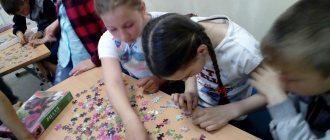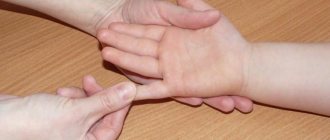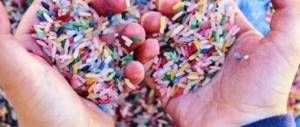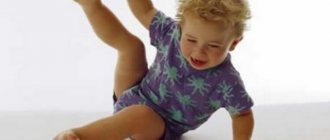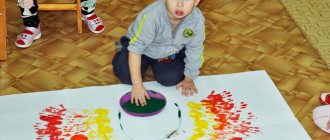Games for developing fine motor skills, middle group
Games for the development of fine motor skills, middle group (card index) can be useful both for parents (grandmothers) and for teachers who are interested in developing their children’s manual dexterity, skill, fine motor skills, preparing the hand for mastering writing, stimulating speech activity of preschool children and the development of interhemispheric interaction.
"Loose Pool"
Goal: Development and increase in fine motor skills and sensitivity of the fingers, massage of the fingers, stimulation of speech activity.
Take any container and fill it, for example, with dry peas (sand, pebbles, any cereal, etc.); before filling, various objects are placed on the bottom of the container, for example, small toys with different properties, buttons, various geometric shapes.
Progress of the game: Children are asked to find various small toys or objects that have been buried. Immersing your hands or fingers into a container with filler, sorting through peas (other cereals or filling material) to find the item at the bottom. When performing this task, the fingers receive a massage effect, which increases their sensitivity and movements become more coordinated. The child finds an object by touch and is asked to talk about it and names it.
You can complicate this game a little, for example, use different container sizes (small or large), combining fillers, which will give a greater massage effect and increase the sensitivity of your fingers, you can also lower one hand at a time (one at a time).
"Colorful Balls"
Goal: Developing the ability to wind balls of thread, developing finger mobility, dexterity and coordination of movements of both hands.
Progress of the game: There are several options for the game:
- The child is asked to unwind and wind the threads onto the ball;
- Competition in a group of children from 3-5. Who reels faster?
- Rewinding from one ball to another (possible in a team). For example, one child winds, the other unwinds.
“Drawing on sand (flour or semolina)”
Goal: Development of precise movements of the fingers, imagination, imaginative thinking, to teach orientation on a plane or projection.
Progress of the game: The child is given a bright-colored tray with sand (kinetic), flour or semolina. The child begins to draw the desired pictures with finger movements: the moon or the sun, the sea with waves, various mountains, favorite characters, cars or just a tree, and if you don’t like it or it doesn’t work out, you can quickly and easily delete everything.
"Games with lids"
Goal: To teach a child to screw and unscrew caps, while developing coordination of finger movements and the ability to form fingers.
How to play: There are several options for playing with lids:
^
- The child is given one bottle with unscrewed caps and he just needs to screw it on and off;
- Team play (2 or more) is given to a bottle with unscrewed caps. The first child in the team screws it on and passes it to the second in the team, who in turn must unscrew the cap and give it to the third, and he screws it on, and so on;
- The child is given two lids, he places his fingers on them (one in each lid) and must move the lids to a certain place on the table. You can also do this in a team game, one on one side of the table, the other on the other table, and whoever moves the lids faster, for example, 2 times.
"Favorite Clothespins"
Goal: Development and strengthening of fine motor skills of the hands, strength of the muscles of the fingers, coordination of the movements of the fingers.
How to play: There are many options for “Favorite Clothespins”:
- The child attaches the missing fragments in the form of clothespins to a flat image, for example: a hedgehog, a sun, a cloud, a cactus, a flower, a fish, a carrot.
- The child attaches one clothespin to the tip of another and so on.
- Team game: clothespins (preferably multi-colored) are placed in a container, and one clothespin is attached to an object nearby, and each child from the team takes turns attaching one clothespin.
Games with a constructor.
Goal: To teach children to construct from many different construction sets that have different ways of connecting parts, creating from them models both according to the designs of the construction set manufacturers, and those invented by the children themselves (to develop the child’s imaginative thinking and imagination) or by the teacher. Develop assembly and disassembly skills, develop fine motor skills of the fingers, coordination of movements and strengthen the hand.
Game "Beads"
Goal: To develop and consolidate visual memory in a child. Teach children to select and show objects of a certain shape and color, both by demonstration and by verbal description. To develop in the child the ability to perform sequential actions in a given task. Develop and strengthen the motor skills of the fingertips by stringing beads onto a cord (fishing line).
Progress of the game: The game can be played in various ways:
- Simply stringing beads onto a cord of the same color as the beads themselves;
- Stringing beads in turns with different colors;
- Stringing beads in turns with different shapes and colors;
- I suggest the kids find the extra bead and fix it.
"Nanny Covers"
Goal: Development and strengthening of fine motor skills of the hands, strength of the muscles of the fingers, coordination of the movements of the fingers, perseverance, attention, to develop the skills of fastening and disconnecting.
How to play: Use lids from Frutonyanya puree.
There are several options for playing with lids:
- The child collects various figures (flower, path, turret);
- Team game (2 or more) collect various figures by attaching one cap at a time;
To the end of the article, I can only add that the above-listed games for the development of fine motor skills, the middle group, are not final and with the proper skill, you can expand the list of games or supplement the existing ones with various options to complicate or simplify.
Summary of a lesson on the development of fine motor skills for children in the middle group of preschool educational institutions
Summary of a lesson on the development of fine motor skills “Let's help a cat” for children of middle preschool age with disabilities.
Author: Ekaterina Arkadyevna Guseva, teacher at the Gatchina Regional Clinical Center for Sons of Sons "Darina". Purpose: this summary may be useful to preschool teachers, additional education teachers, and parents. Form of implementation: subgroup. Goal: development of fine motor skills of the fingers. Objectives: - consolidate knowledge of primary colors; — teach indoor orientation; - develop speech, attention, visual and auditory memory. Equipment: cat toy; massage balls; glomeruli of four colors (red, yellow, green, blue); contours for laying out “Fish”, containers with beans for each child. Preparing for the lesson. Around the group in secluded places, balls of four colors are laid out according to the number of children;
Massage balls, contours for laying out “Fish” and containers with beans have been prepared according to the number of children. Progress of the lesson.
Organizing time. Educator: A guest came to our group today. What kind of animal is playing with me? Doesn't moo, doesn't neigh, doesn't bark, attacks the balls, hides its claws in its paws! (Kitty). (The teacher shows the children a toy cat, the children look at it, touch it, say hello to it.) Let's show the cat how we can play with our fingers. Finger gymnastics “Cat”. A white, fluffy cat washes its tummy with its tongue. (Stroke your left palm with your right palm.) Wash your ears, wash your paws, (Stroke your right palm with your left palm.) And there are scratches on the paws! (Link your index, ring, and little fingers in turn; put your crooked fingers forward like claws.) Our cat seems kind of sad. he says that he was playing with his grandmother's balls and they got lost. Guys, can we help the cat find the balls? (Children look for balls in the group, and having found them, bring them to the teacher, who examines the balls with them, finds out what color they are.) But here’s another problem, the threads in the balls have unraveled. Let's help the cat and wind some strings around the balls. Exercise "Glomeruli". (The teacher shows how to wind a thread on a ball, helps children who have difficulties.) Well done, guys, you helped the cat wind the threads on a ball. Grandma will be happy now, look how cheerful our cat is! Now let’s sit down at the table and play. Self-massage of fingers “Circles”. (Children repeat the words and perform actions with massage balls in accordance with the text.) I roll the ball in circles, I drive it back and forth. I will stroke their palm, as if I were sweeping up a crumb, and I will squeeze it a little, like a cat squeezes its paw. I’ll press the ball with each finger, and I’ll start with the other hand. Guys, our cat is probably hungry from the road. Let's treat him to fish. Exercise "Fish". (Children complete the task - lay out beans along the outline of the “Fish.”) Well done, guys, you tried very hard, you pleased the cat. Our cat really wants to play with you! Round dance game "Vaska the Cat". In the center of the circle, the driver “Vaska the cat” is squatting, his eyes are closed, “sleeping.” The rest of the “mice” children join hands, begin to dance in a circle and say: Vaska the cat is sleeping on the stove, The mice are dancing in a circle. Quieter than a mouse, don’t make any noise, Don’t wake up Vaska the cat, When Vaska the cat wakes up, He’ll break up the whole round dance! At the last words, the leading “cat” wakes up and catches up with the scattering “mice”. The caught participant becomes a “cat” and the game is repeated. Well done guys, the cat really enjoyed visiting you. See you again!
We recommend watching:
Summary of educational activities for children with parents in the middle group. Do-it-yourself doll Summary of a lesson on speech development on the topic “Toys” in the middle group Methodological development of educational activities for the development of communicative activities in children of the middle group A project of artistic and aesthetic orientation for the development of fine motor skills for children of the younger group
Similar articles:
Lesson in the middle group “Winter clothes”
Math lesson notes “Number 1”. Middle group
Card index of didactic games for the development of fine motor skills
Laces
Required equipment: laces.
How we play
: Is your child having trouble tying his shoes? Teach him to do this - it's a great finger exercise. Don’t be upset if it doesn’t work out right away, help him. The store sells colored laces; you can use them to lace a cardboard “shoe” (pierce the holes with a hole punch).
◈ Fastening: you can come up with and make “laced” toys. For example: draw a boat, pierce holes for the waves-cords. Choose laces in different shades of blue and blue - if you thread them through the holes, you will get a beautiful picture. To make it more fun, compete with your child. The one who doesn't miss a single hole wins. Speed is not the main thing here.
Button Glade
Required equipment: coat with buttons.
How we play
: Are you going for a walk? Let's play. The one who doesn't miss a single eyelet and buttons the coat is the winner. Don't rush your child - this is not the main thing.
Finger drawings
The game develops creative imagination
Finger drawings
Necessary equipment: gouache, paper.
How we play
: how much fun finger painting brings to a child! You can draw anything with them: flowers, leaves, paths, furry animals, etc.
And if you draw with your palms, you can draw a Miracle Tree (remember K.I. Chukovsky’s poem “How the Miracle Tree Grows at Our Gate”?). Let the child say what will grow on it. Maybe you too will take part in this?
Necessary equipment: colored paper, old books, magazines.
Torn drawings
The game develops fine motor skills, creative imagination and holistic perception.
How to play: invite your child to tear the paper into small pieces, and then stick the pieces inside the outline of the object. For example, it will be a magical flower or a fabulous tree. You can glue for several days, because this is a painstaking task. You can stick the pieces on top of each other randomly. Use a glue stick. Hang your child’s creation on the wall - it will be very beautiful.
Royal gifts
Required equipment: colored paper.
How we play
: is March 8th or birthday coming soon? Make a fan out of colored paper as a gift. Decorate it with applique. Glue a loop with tape so you can hang the fan on your hand. And if you string several beads or buttons on a thread on a thread, you will get a whole work of art.
Clouds
The game teaches you to stroke by applying the necessary pressure on the pencil.
Necessary equipment: picture - two drawn airplanes, around them a dark and light cloud; soft pencil.
How we play
: Think about watching the clouds outside. There are light clouds, airy ones, and dark ones - rain ones. Because of the dark cloud the plane is almost invisible, but because of the light cloud it is clearly visible. The child will draw other dark and light clouds around the planes himself.
We fix
: “I’m swimming through the water and I’m calling the kids.” You can draw waves for a duck, a boat, etc. It is important that the child tries to apply different pressure on the pencil (there is a storm in the sea - the waves are dark).
Winding paths
The game develops movement accuracy
Necessary equipment: drawn houses and cars, between them at a distance there are simple winding paths (winding, broken curves).
How we play
: Tell your child that he is a driver and needs to drive the car to the house. Be careful on the road - do not go off the path and do not lift your pencil from the paper when driving along curved roads.
◈Reinforce: the child has learned to guide the pencil along such curves - narrow the paths or change the complexity of the curves.
Plasticine drawings
We teach how to make a plasticine background by molding, develop fine motor skills, creative imagination
Necessary equipment: plasticine, peas, rice, millet, buckwheat, cardboard.
How we play
: invite the child to apply an even layer of plasticine onto cardboard, or onto the outline of a picture (vase, bird, tree, etc.), or onto a real object. Then, by pressing, decorate the craft with peas, rice, etc. What it will be is up to you to decide. Or a Christmas tree in the snow made of rice, or a magical bird with feathers made of peas and beans, or stones on the sand - millet and buckwheat on yellow plasticine.
We fix it: what if we cover an old vase with plasticine and decorate it with buttons? You decide.
Don't get your feet wet
The game develops precision movements
Required equipment: drawn circles-bumps. They should be drawn in a sinuous curve close to each other.
How we play
: “Over the bumps, over the bumps, into the hole - bang.” The child needs to walk over the hummocks without getting his feet wet - without going beyond the contours of the hummocks with a pencil, otherwise he will get his feet wet or end up in a swamp. Remind him not to lift his pencil from the paper.
Let's consolidate: maybe you need to lead the wolf along the long road, and the hare along the short one, so that he gets to his home faster? Imagine with your child.
Games and exercises for developing fine motor skills
Bochkareva Natalya Petrovna, teacher of the preschool department “Golden Fish”, Secondary School No. 15, Neftekamsk, village. Power engineer as part of the second stage of the pedagogical marathon “The World of Preschool Children is My World.”
“The origins of children’s abilities and gifts are at their fingertips” V.A. Sukhomlinsky
At 3-4 years old we use all fingers.
Finger theater is an exciting didactic game that:
1. stimulates the development of fine motor skills;
2. introduces the child to such concepts as shape, color, size;
Advertising message
3. helps develop spatial perception (concepts: right, left, next to each other, who is in front, etc.);
4. develops imagination, memory, thinking, attention, speech.
5. helps develop vocabulary and activates speech functions;
For inept children's fingers, such a toy will be very useful - a button-fastening simulator.
Lacing games:
1. develop sensorimotor coordination and fine motor skills of the hands;
2. develop spatial orientation, contribute to the assimilation of the concepts “above”, “below”, “right”, “left”;
3. develop lacing skills (lacing, tying a lace into a bow);
4. promote speech development;
5. develop creative abilities;
6. develop perseverance;
We can say that the lace is a snake; it likes to crawl around the house (crawl through holes). When a child pulls a lace through the holes, pay the child’s attention to the location of the lace on the “house” - at the top or bottom, on the right or left, in the center. Tell where the snake wants to crawl, let the baby help it.
Games with cereals, seeds, sticks.
Cereals are a universal material. You can just tinker with it or create a real masterpiece.
Take a tray and scatter small grains (for example, semolina) on it. You can't imagine a better drawing board. First, the adult draws lines on the “board”, and the child repeats. Let these be very simple shapes: squares, circles, zigzags. Snowman, house, sun.
Pour dry peas into a mug. The child transfers the peas one by one to another mug. First with one hand, then with both hands at the same time, alternately with the thumb and middle finger, thumb and ring finger, thumb and little finger.
Place the beans on a saucer. The child takes the bean with his thumb and forefinger and holds it with the other fingers (as when picking berries), then takes the next bean, then another and another - so he picks up a whole handful. You can do this with one or two hands.
You can use sticks to make images of objects.
Bags of cereal are exercises for the development of tactile sensitivity and complexly coordinated movements of the fingers and hands.
· develop fine motor skills;
develop attention; speech;
· develop memory (after all, you need to remember which pouch has already been examined so as not to touch it twice.)
Naturally, the younger the child, the fewer pouches he will have to examine. You can combine the game with loops and hooks with the game “Magic Bag”. To do this, you will need several small cloth bags of the same size. Place a small toy or object in each bag. And hang it all on hooks. Name the child the object he has to find. Offer to remove the bags from the hooks one by one and feel the object without removing or opening the bag. If the bag does not contain what you need, you need to hang it up and move on to the next bag.
Exercises with clothespins
The purpose of the exercise is to teach the child to attach clothespins independently. To make the game interesting for a child, you can attach clothespins according to the theme (that is, rays to the sun, needles to a hedgehog, rain to a cloud, grass to the ground, and the like; for this you need, accordingly, to make preparations for the sun, hedgehog, and so on ).
Exercises with beads.
Various stringing exercises are excellent for developing the hand. You can string anything that can be strung: buttons, beads, horns and pasta, dryers, etc. You can make beads from cardboard circles, squares, hearts, tree leaves, including dry rowan berries. Learning how to pierce neat holes is also useful. The size of the beads depends on the age of the child. First, instead of beads, you can use balls from pyramids with round parts and string them on a thick cord; then the parts need to be gradually “crushed”
Laying out figures using beads.
For the exercise, medium-sized beads already strung are used. The purpose of the exercise is to teach the child to lay out the outlines of objects, a heart, a spiral, etc. from beads, while talking with the child.
Productive activity.
In addition to games and exercises, various types of productive activities (drawing, modeling, appliqué, design, etc.) also contribute to the development of speech. All these types of productive activities unobtrusively help children communicate in a group. Review and evaluate the work of your friends.
Exercises with paints.
Some teachers and psychologists offer exercises with paints to develop motor skills. They consist in the fact that the child dips his finger in watercolor or gouache paint, and then applies his “drawing” to a sheet of paper. These exercises can be done from 2 years of age.
Games with construction sets and mosaics - at this time, not only imaginative thinking develops, but also imagination and fine motor skills. The child tells what he did and shows everyone.
Rearrange the toys.
Goal : Learn to grasp small objects with a pinch, develop coordination actions of both hands.
Equipment. Small objects (chips, buttons, mosaic, tall vessel).
Progress of the game.
The teacher shows fingers folded in a pinch. He takes small objects and throws them into the vessel, drawing the children’s attention to the fact that he is holding the vessel with his other hand. Invites the children to do the same. Hearing an adult, the child repeats and expands his vocabulary of words in speech.
The doll came from a walk.
Purpose: To teach children to unfasten buttons; continue to develop fine hand movements; to generate interest in mastering object-based game actions by asking children questions.
Equipment. Doll. Clothing to go with it (buttoned sweaters, coats).
Progress of the game.
A doll comes to the children and asks them to help her undress, because she does not know how to unfasten buttons. Children are asked to help the doll. The teacher names the words of clothing, and the children repeat.
Games are played in a similar way: “Let’s dress the doll for a walk” - children fasten the buttons. “Let’s put the doll to sleep” - children unbutton smaller buttons on the dolls’ clothes: (sundresses, blouses, vests).
Help Dunno.
Goal: To teach children to fasten buttons, develop small hand movements, form a positive attitude towards the game, developing the child’s speech.
Progress of the game . The teacher shows Dunno and says that he wants to collect a flower from the petals, but he doesn’t know how, he needs to help him. Then he explains to the children how to sequentially put loops of petals on buttons and distribute them around the button to create a beautiful flower. Dunno rejoices and thanks the children.
Puzzles are colorful pictures of the world around us.
The game develops attentiveness, intelligence, speech,
coordination of the work of the eyes and hands.
Games with sensory mats.
Goal: To teach children to fasten fasteners, developing speech.
Vocabulary work is closely related to the child’s familiarization with the world of things, phenomena, their properties and qualities. From object to word and from word to object are two interrelated approaches.
Laying out the mosaic.
Goal: To teach children to grasp with a pinch, to develop attention, speech, imitation, the ability to analyze and produce a simple sample.
Material: mosaic, small story toys - nesting dolls, dolls, bunnies.
Progress of the game. The teacher shows the children the mosaic board and draws the children's attention to the holes. He takes one mosaic element and together with the child examines the hat and pin. Shows how to insert the mold into the hole hole. Teaches you how to take shape with a pinch. Children lay out paths for matryoshka dolls.
By folding your fingers in a certain way, you can get images of different objects, animals, birds.
Bunnies. The little finger and ring finger are bent and held with the thumb - the muzzle, and the other 2 fingers rise up - the ears.
Geese. Press 4 fingers together and press your thumb underneath them.
Snail . One hand is clenched into a fist, and the other is under the fist with the index and middle fingers extended.
Glasses. The thumb and index fingers together form rings, straighten the remaining fingers.
The grandmother put on her glasses and her granddaughter saw them.
Checkbox. Four fingers (index, middle, ring and little fingers) together, thumb down. Back of the hand towards you.
The flag is burning in the sun, as if I had lit a fire.
Boat. Both palms are placed on the edge, the thumbs are pressed to the palm.
The boat floats along the river, leaving rings on the water.
Christmas tree . The fingers are passed between each other, palms at an angle to each other.
Cat . The middle and ring fingers rest against the thumb. Raise your index and little fingers up. And the cat has ears on the top of her head so that she can better hear the mouse in her hole.
The game “Catch a Fish ” promotes the development of flexor and extensor movements of the hands in children.
Progress of the game.
Children catch fish and take them to the aquarium.
Game "Make a whole toy."
Goal: To teach children to fasten buttons while developing speech.
Progress of the game.
The teacher shows a figurine of a bear. He examines it with the children, paying attention to individual parts: head, torso, paws. Explains that the head is at the top, the body is at the bottom, and the paws are on the sides. Then the teacher shows how to make a bear, composing it from parts. First, all the parts are placed on the table, then all the buttons are fastened, connecting all the parts together. They invite the children to make the same bears.
Application "Ornament".
Goal: To teach children to perceive and reproduce the relative positions of geometric shapes on a plane, taking into account color and shape.
Material: sample ornament (green square in the center, red circles in the corners). Handout: sheets of paper with a contour image of the same ornament: 4 red and 4 green circles cut out of cardboard; 4 red and 4 green squares.
Management . Children, look how beautiful our napkin is. That's right, the square is green. What is her figure in the middle?
This napkin also has decorations in the corners. What figures are glued in the corners? That's right, these are circles, red circles. Then the teacher invites the children to decorate their napkins.
“You have a lot of different figures. Choose different figures and arrange them on napkins just like this one. When you're done, leave your napkins on the tables.
To form a vocabulary for children, a variety of demonstration materials are used:
Toys, objects, pictures, tabletop theater figurines, bi-ba-bo dolls, waste material - corks, flannelgraph with illustrations.
An object is shown and called (Children look at and name what they see.)
Finger games, physical minutes and tasks are used.
New words are repeated many times individually and in chorus, which helps to enrich the vocabulary of words in children.
Questions are asked to the children: “What do you see? Which subject? Who do you see in the picture? What are they doing?"
Orders are used (Find, bring.)
The ability to correctly use intonation means of expressive speech when pronouncing tongue twisters is developed. Speak loudly, quietly, quickly, slowly).
Working with pictures, children sort through them, name them, and expand their vocabulary.
Through play, the emotional life of children becomes richer and more diverse, creativity develops, and all this increases speech activity.
Thus, as a result of the work done, I came to the conclusion that purposeful, systematic and planned work on the development of fine motor skills in preschool children contributes to the formation of speech.
Did you like the article?
Vote for Natalya Petrovna’s work - press the social network buttons, write comments!
You can view the works of the marathon participants HERE.
Partner promotions
